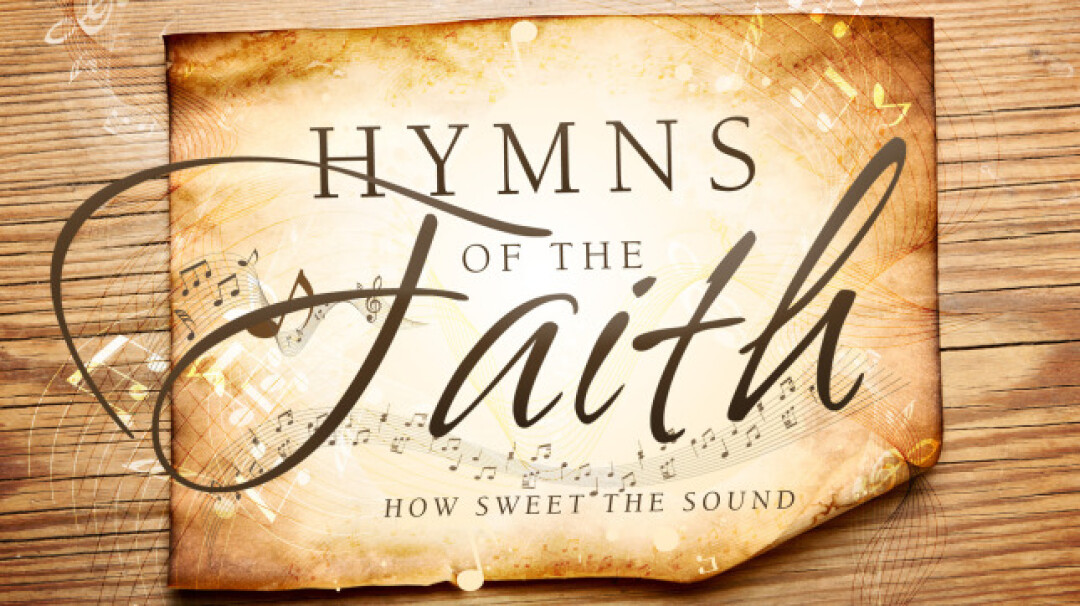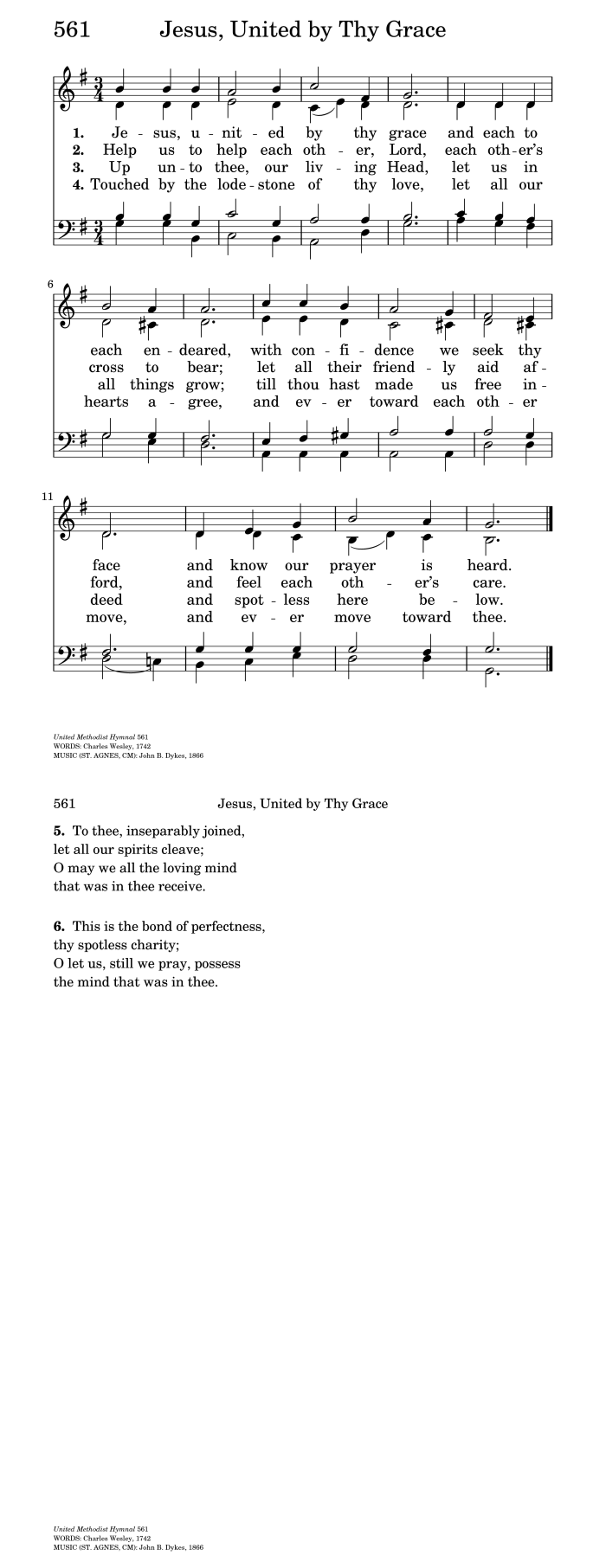

“Jesus, United by Thy Grace”
by Charles Wesley
The United Methodist Hymnal, 561
Jesus [Jesu], united by thy grace
and each to each endeared,
with confidence we seek thy face
and know our prayer is heard.
“Jesus, United by Thy Grace” was the closing hymn at Pender's 9:00 am Traditional Service on September 3, 2023 It was sung by Pender's congregation and accompanied on piano by Heidi Jacobs.
The Pender UMC Traditional Service Closing Hymn “Jesus United by Thy Grace" on Sunday July 24, 2022 was played by Liz Sellers on piano and sung by Brian Stevenson and the Pender Congregation.
This hymn appeared first in the collection titled Hymns and Sacred Poems (1742), one of a series of collections published by the Wesley brothers bearing this title. This hymn must have been prominent in the Wesley canon, since all nine of the original stanzas were included nearly forty years later in the monumental A Collection of Hymns for the Use of the People called Methodists (1780) in the section “For the Society, Praying.” Published initially as a long four-part hymn with twenty-nine stanzas titled “A Prayer for Persons Joined in Fellowship,” most of six stanzas in The United Methodist Hymnal come from Part IV. Though appearing as a unified theological whole in the hymnal, this is an excellent example of careful editing. Stanza 1 comes from Part IV (stanza 1). Stanza 2 is taken from Part 1 (stanza 3). Stanza 3 was first cited in Part I (stanza 5). The remaining stanzas (4, 5, and 6) are from Part IV (stanzas 4-6) (Young, 1993, p. 449).
The preface to the collection (most likely by John Wesley) focuses on the Christian perfection doctrine. A misunderstanding at that time was that Christians could achieve perfection in this life. This misinterpretation of Christian perfection was causing disunity in the Methodist fellowship (See J. Wesley, “Christian Perfection,” 1741). John Wesley states his position in the Preface of this collection in unequivocal terms:
First, we not only allow, but earnestly contend. . . that there is no Perfection in this life which implies any dispensation from attending all the ordinances of God; or from doing good unto all men, while we have time, though especially unto the household of faith. And whosoever they are who have taught otherwise, we are convinced are not taught of God. We dare not receive them, neither bid them Godspeed, lest we be partakers of their evil deeds (Wesleys, 1742, pp. i-ii).
Nourishing Christian unity was a part of the process of Christian perfection. The preface to the earlier 1739 collection offers an expansion of the strong message of Christian unity conveyed by the hymn text. Citing Ephesians 4:15-16, the Wesleys emphasize that “we are knit together [my emphasis], that we have nourishment from him, and increase with the increase of God” (J. Wesley, 1739, p. vii).
Each of the stanzas chosen for The United Methodist Hymnal emphasizes unity in some way:
Stanza 1: “united by thy grace”
Stanza 2: “Help us to help each other, Lord, / each other’s cross to bear”
Stanza 3: “Up unto thee, our living Head, / let us in all things grow”
Stanza 4: “let all our hearts agree, / and ever toward each other move”
Stanza 5: “To thee, inseparably joined, / let all our spirit’s cleave”
Stanza 6: “This is the bond of perfectness, / thy spotless charity”
Charles Wesley employs a particularly original metaphor in stanza 4—“Touched by the loadstone of thy love, / let all our hearts agree. . .”. British Wesley scholar, J.R. Watson, notes that this stanza “has proved very attractive to hymnbook editors” (Watson, Canterbury Dictionary, n.p.). A loadstone has strong magnetic qualities. Thus, the sonorous alliterative pairing—loadstone/love—is also a theological truth that stresses the magnetic (attractive) quality of God’s love—a love that draws us to God. This magnetic quality underscores the reality that God takes the initiative in God’s relationship with humanity.
The final two of the three omitted stanzas employ soaring language that moves us toward eschatological truth, a common destination in Charles Wesley’s hymns, and beyond the present-day text’s focus on Christian living while on earth:
With ease our souls through death shall glide
Into their paradise,
And thence on wings of angels ride
Triumphant through the skies.
Yet when the fullest joy is given,
The same delight we prove,
In earth, in paradise, in heaven
Our all in all is love.
The published text remains grounded in Christian unity only possible through the grace of Jesus, rather than on the commonality of opinion or politics. Given these times in which we live and the state of disunity in the church, these words serve as a reminder that we are joined with one another through our determination to be one in mind with Jesus. According to the hymn, the commitment to be one in Christ results in "the bond of perfectness,” while acknowledging continuing need to pray that we “possess the mind that was in thee” (stanza 6).
S T Kimbrough Jr. refers to Charles Wesley as a lyrical theologian, defining Charles’ theology as one “couched in poetry, song, and liturgy, characterized by rhythm and expressive of emotion and sentiment” (Kimbrough, 2014, p. 3). Kimbrough points out that some Wesley hymns (such as this one) demonstrate Wesley’s “way of working through theological issues, thought and concepts, and of shaping theological ideas,” through the use of poetry (Kimbrough, 2014, p. 54). This compelling text provides a thorough “working through” of this theme for a service focused on unity. As lyrical theology, the hymn might be sung in a variety of worship contexts. The Common Meter (C.M.) text allows for a variety of tune options in addition to ST. AGNES printed in The United Methodist Hymnal. In the more than 150 hymnals in which this hymn appears in Hymnary.org, hymnal editors pair eleven tunes with this text. Common Meter presents an opportunity to consider which tune would be the most appropriate contextually. In a lament-focused worship service, the slower, more somber ST. AGNES may be a reflective choice. If the focus on unity intends a more firm and declamatory statement of faith and unity, AZMON could be a compelling expression of the words in the opening stanza, “with confidence we seek thy face and know our prayer is heard.”
This hymn, with its focus on unity through Christ, articulates a lyrical theology that may prove helpful when considering the complex and divisive issues present today in church and society.
Adapted from https://www.umcdiscipleship.org/articles/history-of-hymns-jesus-united-by-thy-grace


